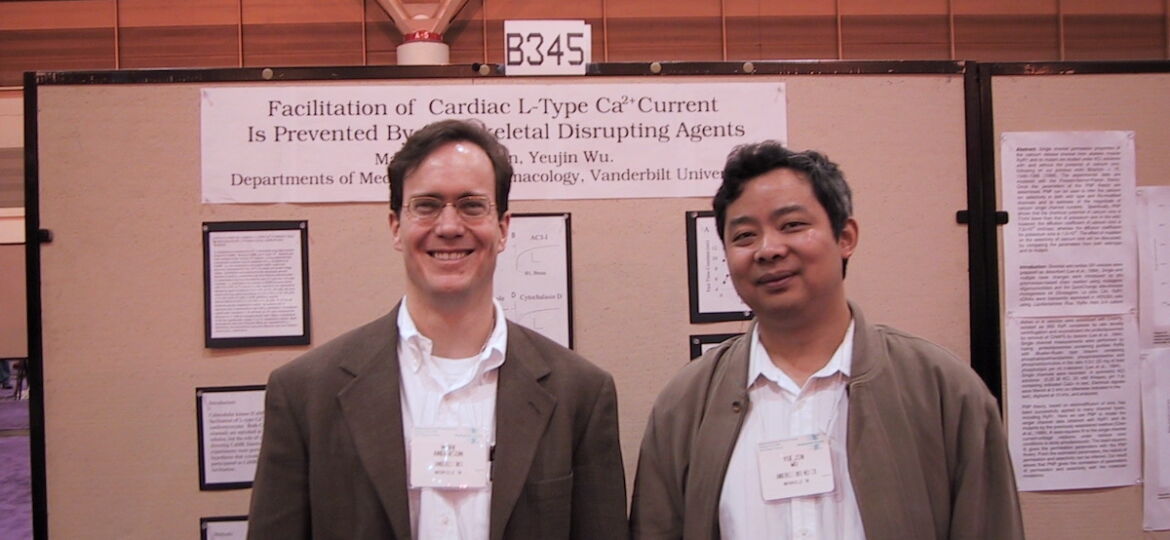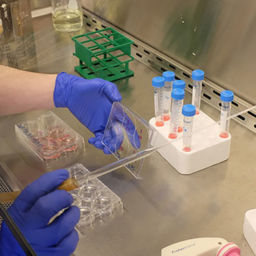
After three decades of research, Dean Anderson remains on CaMKII and its underappreciated role in heart function.
By Alison Caldwell, PhD
Growing up, Mark Anderson, MD, PhD, always thought that he’d be a lawyer. “Mostly because I didn’t want to feel like I was predestined to become a doctor,” he said, referencing the fact that his grandmother, grandfather and father were all physicians themselves. “But I always liked biology, and in the end, I really loved science, so I ended up going to medical school.”
It was thanks to an ex-girlfriend that he also pursued a doctoral degree; not wanting to leave her behind in his pursuit of medicine, he opted to defer medical school and instead start with a PhD program. “The relationship didn’t last, but the fascination with ion channels did,” Anderson, now Dean of the Biological Sciences Division (BSD) and Pritzker School of Medicine and Executive Vice President for Medical Affairs for the University of Chicago, said with a laugh.
It was during his fellowship years at Stanford University that he first encountered the life-long subject of his study: Ca2+/calmodulin-dependent protein kinase II. Better known as CaMKII, the protein kinase is part of a variety of signaling cascades, and is perhaps best known for its role in the brain, where it is believed to play key roles in learning and memory. CaMKII is also critical to cardiomyocytes, the muscle cells of the heart, because it maintains calcium homeostasis and reuptake, supporting an optimal environment for heart activity.
Misregulation of CaMKII has been linked to arrhythmia in the heart, which drew Anderson’s clinical interest. “The protein seemed to be driving important electrophysiological phenotypes in the heart, which is what I was studying at the time,” he said. “My PhD thesis was focused on how the heart muscle contracts, and then when I went to medical school, the early electrophysiology labs looked a lot like my research labs. It felt so familiar, but it was also an emerging field, with new options for modifying the electrical activity of the heart nonsurgically.”
During his decades-long research career, including time as the director of the Department of Medicine, the William Osler Professor of Medicine and physician-in-chief of The Johns Hopkins Hospital and as chairman and department executive officer of internal medicine at the University of Iowa Carver College of Medicine, he has continued to focus on understanding the roles of CaMKII in heart health, and how targeting the protein might provide new therapeutic opportunities for conditions such as arrhythmia and myocardial ischemia-reperfusion injuries.
In the heart, activation of CaMKII mediates the phosphorylation of ion channels and other proteins that contribute to rapid changes in heart activity, including in heart rate and contractile performance of the heart muscles. This activation can be critical for rapid state changes, such as initiating a fight-or-flight response in the body, but overactivation can lead to impaired heart function and cell death, which can in turn lead to poor heart health outcomes.
One of Anderson’s seminal discoveries came in a 2008 study, in which his team outlined a new mechanism for the activation of CaMKII — oxidation of the amino acid methionine within the protein can sustain its activity even without the presence of calcium or calmodulin. As a result, CaMKII can be activated by angiotensin II (AngII)-induced oxidation, which in turn leads to apoptosis (cell death) in cardiomyocytes.
Additional research from his lab since then has shown that oxidized CaMKII can trigger atrial fibrillation, drawing a line between known risk factors and the condition, and demonstrating directly that patients with atrial fibrillation showed increased levels of oxidized CaMKII in their atria.
More recently, Anderson’s team has found evidence that this mechanism is a result of evolutionary tradeoffs between traits that increase youthful fitness but ultimately negatively impact health during aging. The activation of CaMKII by reactive oxygen species provides an advantage to vertebrates by leading to increased intracellular calcium, which in turn activates transcriptional programs important during exercise and in supporting the immune system, though overactivation of the system can have negative impacts on long-term heart health. This means that the system operates in a balance, supporting a foundational evolutionary theory known as antagonistic pleiotropy — the idea that age-related diseases are a result of genetic traits that evolved because they were beneficial during the earlier reproductive years.
All of this research, he says, points to the potential for targeting CaMKII to treat abnormal heart rhythms, including atrial fibrillation, and heart failure — something that has yet to be studied in a clinical trial. One of the challenges is the fact that CaMKII is such an important molecule in the brain. “Pharmaceutical companies haven’t developed CaMKII inhibitors because there’s a concern that they might impact learning and memory,” he explained. “But our team has been conducting high-throughput screens of medications that are already in use in patients for other reasons and we’ve identified several that appear to inhibit CaMKII, which provides some evidence that we might be able to block or reduce its activity without major adverse effects.”
He hopes that inhibiting overactive CaMKII could have a “two-for-one” effect of preventing both arrhythmias and heart failure, based on the results his team and others have seen in mouse models. “Many of the drugs we currently have can make people feel a little better for a while, but ultimately results in them dying more quickly,” he said. “CaMKII really seems to be the sweet spot.”
The future will see the use of new techniques to even more selectively target CaMKII oxidation in the heart. He points to a recent study in Science out of the University of Texas Southwestern Medical Center where researchers used CRISPR to target and modify the methionine site on the form of CaMKII most prevalent in cardiac tissue. By changing the methionine to a valine, the amino acid found in invertebrate CaMKII, they were able to prevent oxidation and therefore hyperactivation of the protein. This, in turn, protected against heart failure without causing global inhibition of CaMKII, thus eliminating any effect on the brain.
As he settles into his new role at UChicago, Anderson is unsure about the next steps for his research, but he continues to work on raising the profile of CaMKII as a target in heart health.
“It is possible that selective elimination of oxidative activation of CaMKII through technologies such as CRISPR could broadly benefit therapies for patients suffering myocardial infarction (heart attack) as well as arrhythmias and non-cardiac diseases such as asthma and some cancers,” he said. “It is exciting to consider how future therapies could target specific harmful enzyme activities without inhibiting core enzymatic signaling, which may be required to sustain normal physiological processes.”
This story was originally published in Medicine on the Midway.



